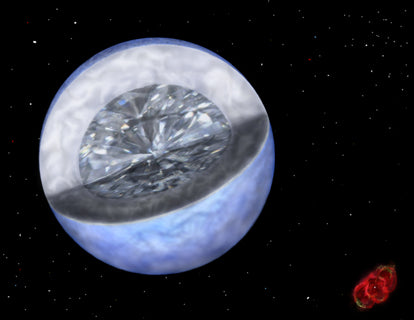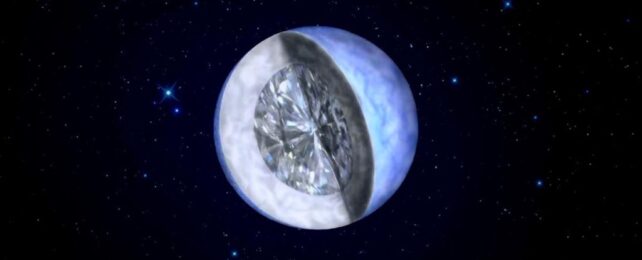
University of Southern Queensland Discovers 'Diamond Star'
Share
When we look up at the night sky, stars appear like sparkling jewels, shimmering in the dark expanse. And guess what? Some stars might actually be turning into diamonds!
Scientists have recently discovered a special type of dead star, known as a white dwarf, that is undergoing a fascinating transformation right in our cosmic neighborhood. This white dwarf, located just 104 light-years away, is primarily made up of carbon and metallic oxygen. As it cools down over time, its center is gradually crystallizing, forming a dense and solid structure resembling a "cosmic diamond."

A team of international astronomers, led by Alexander Venner from the University of Southern Queensland in Australia, explains in their work how they identified a new quadruple star system, similar to Sirius, located at a distance of 32 parsecs. This system consists of a crystallizing white dwarf that orbits a previously known triple star system called HD 190412.
By studying this system and its associated companions, the researchers were able to externally determine the total age of the crystallizing white dwarf. This is the first time that the age of a crystallizing white dwarf has been accurately measured, and it provides valuable insights into the cooling delay caused by core crystallization.
In the vast Universe, everything undergoes change. Every star, which shines brightly due to the energy produced by atomic fusion, eventually exhausts its fuel and goes through a transformation.
For most stars, including our Sun, this transformation leads to the formation of a white dwarf. When a star runs out of fuel, its outer material is expelled into space, leaving behind a core that collapses inward due to the lack of fusion pressure. This core becomes an ultradense object roughly the size of Earth (or the Moon!) but containing as much mass as 1.4 Suns.
The matter within white dwarf stars is extremely compressed, yet it is prevented from collapsing further by electron degeneracy pressure. This pressure arises from the quantum mechanical principle that no two electrons can occupy the same state. It keeps the white dwarf from becoming even denser, as observed in neutron stars or black holes.
White dwarf stars are faint, but they continue to emit residual heat. Over time, they cool down and are expected to evolve into something called black dwarf stars, which are cold and composed of crystallized carbon.
According to calculations, this cooling and crystallization process takes an incredibly long time—about a quadrillion years (that's one million billion years). Since the Universe itself is only around 13.8 billion years old, it is unlikely that we will encounter a black dwarf anytime soon.

However, we can study the early stages of crystallization in white dwarf cores by examining the signs of this process. During crystallization, the carbon and oxygen atoms within the white dwarf stop moving freely and start forming bonds, arranging themselves into a crystal lattice. Energy is released during this transformation, which dissipates as heat.
This crystallization process causes a plateau or slowing down in the cooling of white dwarf stars. By observing the changes in the star's color and brightness, we can deduce its age. However, accurately determining the brightness of a star requires precise knowledge of its distance. Thanks to the high-precision stellar mapping conducted by the Gaia mission in recent years, we now have improved capabilities to identify crystallizing white dwarfs with confidence.
Venner and his team utilized data from the Gaia mission to search for multiple star systems, focusing on stars whose associations with others were not clearly understood. Through their research, they discovered that a previously identified white dwarf star, now known as HD 190412 C, was gravitationally linked to what was originally believed to be a system of three stars named HD 190412.
The identification of the white dwarf transformed the triplet system into a quadruplet. Moreover, the characteristics of the white dwarf indicated that it was undergoing the crystallization process.
While we do not yet know if the crystal forming within the white dwarf is diamond-like, it is worth noting that white dwarfs have a density of about 1 million kilograms per cubic meter, while diamonds have a density of approximately 3,500 kilograms per cubic meter. There are denser forms of carbon than diamond, and it is also possible that there are diamonds floating around in space.
The other three stars in the system allowed the team to estimate the age of the white dwarf externally—an achievement that had not been accomplished before for a known crystallizing white dwarf. The system's overall age is around 7.3 billion years, while the white dwarf's age is estimated to be around 4.2 billion years. The difference of 3.1 billion years suggests that the crystallization process has slowed down the cooling of the white dwarf by approximately 1 billion years.
Although this dating alone is not sufficient to alter our models of white dwarf crystallization, the discovery and its proximity to Earth indicate that there may be numerous similar systems in the Universe that we can study to better understand this captivating process.
The researchers suggest that the discovery of the HD 190412 system opens up new possibilities for investigating crystallizing white dwarfs. It may enable us to refine our understanding of these fascinating objects and provide stronger tests for white dwarf crystallization models.
In conclusion, stars have incredible journeys, and some of them may end up transforming into cosmic diamonds. This recent discovery brings us closer to unraveling the mysteries of white dwarfs and their evolution. The Universe continues to astonish us with its wonders, reminding us of the vastness and beauty that lie beyond our planet.
You’ve come this far…
Why not venture a little further into A.S.S. - our exclusive Australian Space Society.
And keep thrusting Australia into the deep unknown…
#Space_Aus




